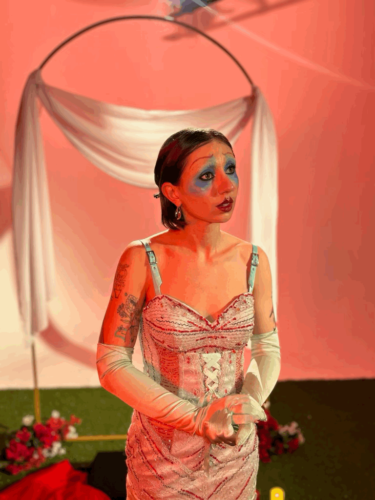Posted: by The Alt Editing Staff
The Noisy’s Sara Mae has been featured on this site before, both as an artist and as a contributor; now, however, we’re excited to bring you some of their work in an entirely new light. Today we’ve got some excerpts of their forthcoming novella, titled Lawn Madonna, for your reading pleasure. About this project Sara Mae shares
I was writing the record while in my MFA for poetry in Knoxville, Tennessee. I was also taking fiction workshops through school, and I’d begun drafting a novella from the POV of a Virgin Mary statue in Boston’s North End during the Great Molasses Flood of 1919. I finally finished my first complete draft of it earlier this summer, and I wanted to share some excerpts to celebrate our song “Backlit!” “Backlit” is about my perspective, but this novella is about Miss Mary’s, as well as some other girl saints. I tried to write this story as a poem, as a song, and fiction became the only container that made sense to hold it, but you can maybe catch the remnants of that storytelling in the lyrics and visual world of this song.
Excerpts from this novella have been published in The Offing, and the project in its entirety will hopefully be published in the next few years.
So without further ado, here are some pieces from my novella-in-progress, Lawn Madonna.
Well, who are we to argue with that? Without further ado, find excerpts of Lawn Madonna below, and give The Noisy’s The Secret Ingredient Is Even More Meat, a deluxe edition of last year’s The Secret Ingredient Is More Meat, a listen while you do.
Alternative Story of the Virgin Mary
When the Great Molasses Flood of 1919 struck, the animals came in twos and our Mary loved them all because she was bisexual. They wore furs of sap, they crawled towards her, they begged. It was difficult to be satisfied. It was odd to her how the sea of saccharine, could-be ammunition smelled sharp, bitter, as though the molasses wanted to become weaponry. And as the animals writhed in it, their hooves, their claws, their palms, stuck in a kind of gluttony, eeking prayers to her, a statue, from closing throats, Mother Mary, she realized, perhaps the sweetest things always became dangerous.
Mary
That she had never seen the ocean was important. On quieter nights, our Mary could hear women rounding Salem Street, muffling delicate gasps at the view, something to behold just for themselves, maybe the way the sky placed its palm on the water, the cemetery askew in the womens’ field of vision where the bones of the settlers never settled, and memento mori were cast in stone. When she was a mountain, Mary’s people came to touch her in the final lengths of their shepherding, their foragerey, & breathe the breath of aliveness. Here in the North End, they asked her for it hourly. Give us permission to go on. She arrived to Boston in a crate, and by a five-foot-nothing-man’s hands, emerged as a small piece of herself, polished. And the believers touched her feet until bright spots shone from the marble there, more of her worn away, more of her revealed.
She knew the briny air of the harbor, and how it visited her, if only to weep from her own marble shoulders, and in the summer it’s humidity gave women a kind of butter yellow aura, and men a handsome ring of sweat between their shoulders, that made them loosen their ties, and drove believers to more compelling confessions. She knew the ocean by what it touched. She knew its voice–almost the sound of crinoline rustling–and its hands, how it ran through the hair of teenagers showing off to their friends and diving in, and wetting down this decade’s curls–and foreshadowing the next’s slick bobs.
She knew the way Mariano Esposito felt his first days in the Navy, and what wrestled inside of him, the ocean itself alive in his veins, the drills and haircuts and hazing hangover routines that stilled those waters, seemed to give him purpose, and the way he felt as a child when his father held him just over the edge of the sailboat, to touch the wake on a gusty spring day, and when he ran away with nothing but his linen suit, and learned the stars until they stayed on the backs of his eyelids, so at night he dreamt in pathways, in shiny things to follow: clutches of wet flowers in a woman’s hands, the sugared yolk of sun looking back at him between rooftops. She knew what the docks off Commercial Street looked like in his eyes, Battery Wharf, the mallards and their green heads in summer moseying along the water’s surface collecting sun in their ears, the barnacles up the sides of the pilings like stockings, the sounds of sailors landing on the dock and tying off cleats deftly, what reminded Mariano of his father. Mary knew because he prayed to her.
Mary knew how Amara Vecchi frequented the harbor on her walking spells, when she got that feeling of fullness in her body made up of voices, constricted heartbeats, tightness, tightness, until she had to move, even if it was late at night, and she risked being attacked, or betraying her parents’ trust, she found the ocean and gazed upon it, as if that emptied something inside of her, and she was a tank, a vessel, to be made the way the ocean wanted her. On her return, she would visit Mary and apologize, plead, and tell her stories.
Mary learned of the ocean’s bitterness from the priest, Father Sabatino, who fell in winter once, and sustained fainting spells from the incident. Mary knew the ocean for the way it cooled the forehead of the florist, Campana on lunch breaks, the rocking that the Pagano child would remember and without knowing seek to recreate, chasing adrenaline, because once when his mother was pregnant with him, she spent the day in the shallows, eyes closed in relief. In this way, Mary loved the ocean because she saw the water moving through the ones she loved, and she longed for an ocean of her own, with something akin to jealousy, the color of coral.
Alternative Story of Saint Lucy
She figured it out before the rest of us—the eyes are birds curled up in the nests of their sockets. She knew it was only a matter of time before they flew away. When they did, it was cloudy. She worried for their journey, wondered if they would have kids. In her flightless dark, she felt around for feathers, kept a collection, asked lovers to describe the colors to her while they tickled her in her most secret places. Affection was how you were handed back to yourself, she told us. She preened when she heard the colors in somebody else’s mouth.
Alternative Story of Saint Lucy
I lie like an optimistic river. I lie to fill my pockets with stones. I lie because once my mother found ricotta on my tongue, and she made me the cattle’s moon. I was orbited for months. The goats and their horns chattered beneath the zodiac. I gave them our yard to shut them up. Never enough pasture. I took to folding rocks into their purple ribbon tongues. I thought it would punish them, weigh down the current of their talking. Instead, castles erected from their bellies and my mother praised me, kept me out in the fields, the milk flowing. You could say Lucy taught me how to lie, but really it was the girl a year and three inches above me with teeth like stamens, curly. We called her the bee eater. She put her mouth on me and I stung all over. This was years ago, and my lies since have spread like pollen: I didn’t enjoy it. My limbs didn’t open to the light, squash leaf, hairiness, greedy.
––
Zac Djamoos | @gr8whitebison
The Alternative is ad-free and 100% supported by our readers. If you’d like to help us produce more content and promote more great new music, please consider donating to our Patreon page, which also allows you to receive sweet perks like free albums and The Alternative merch. And if you want The Alternative delivered straight to your inbox every month, sign up for our free newsletter. Either way, thanks for reading!


